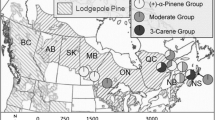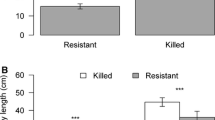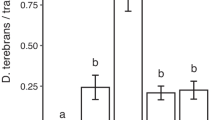Abstract
The effects of host tree monoterpenes on primary and secondary attraction of the bark beetles, Ips pini and Ips grandicollis, and their associated phloeophagous insects were investigated. Monoterpenes alone were not attractive to I. pini. However, monoterpenes mediated the attraction of I. pini to its aggregation pheromones. With the exception of 3–carene, the effect of monoterpenes on I. pini's response to its pheromone, ipsdienol plus lanierone, was inhibitory. In contrast, (−)-α-pinene both attracted I. grandicollis and enhanced the attraction of I. grandicollis to its pheromone, ipsenol. No monoterpene inhibited the response of I. grandicollis to its pheromone. The inhibitory effect of host monoterpenes on I. pini response to its aggregation pheromone differs from previous work, in which monoterpenes either synergized responses or had no effect. In addition to possible geographic differences, the concentrations used in our study simulated trees that had begun to respond to attack, whereas previous studies deployed lower concentrations, which simulated constitutive phloem from unattacked trees. These results support the view that trees that undergo induced responses to bark beetles sometimes inhibit attraction of additional beetles, despite the beetles' production of aggregation pheromones. Neither species displayed cross-attraction to the pheromone of the other. The red turpentine beetle, Dendroctonus valens, showed weak and consistent attraction to (+)-α-pinene and in some cases to (−)-α-pinene. Attraction to (−)-α-pinene was usually enhanced by Ips spp. pheromones. The absence of strong attraction to (+)-α-pinene and partial attraction to (−)-α-pinene suggest that the effects of different stereoisomers of α-pinene on D. valens vary throughout its geographical range. Hylastes porculus was also attracted to some monoterpenes, particularly (−)-α-pinene. An additional 10 species of phloeophagous insects were caught in response to monoterpenes and/or pheromones, including the pine root weevils, Hylobius pales and Pachylobius picivorus, and the longhorned beetle, Monochamus carolinensis.
Similar content being viewed by others
REFERENCES
Aukema, B., Dahlsten, D. L., and Raffa, K. F. 2000. Improved population monitoring by incorporating behavioral disparities among predators and prey: Relating bark beetle and predator arrival rates to various synthetic lures vs. infested host. Environ. Entomol. 29:618–629.
Bartelt, R. J., Schaner, A. M., and Jackson, L. L. 1986. Aggregation pheromones in five taxa of the Drosophila virilis species group. Physiol. Entomol. 11:367–376.
Bedard, W. D., Ferrell, G. T., Whitmore, M. C., and Robertson, A. S. 1990. Trapping evaluation of black stain root disease in Douglas-fir. Can. Entomol. 122:459–468.
Billings, R. F. 1985. Southern pine beetles and associated insects. Effects of rapidly-released host volatiles on response to aggregation pheromones. Z. Angew. Entomol. 99:483–491.
Billings, R. F., Gara, R. I., and Hrutfiord, B. F. 1976. Influence of ponderosa pine resin volatiles on the response of Dendroctonus ponderosae to synthetic trans-verbenol. Environ. Entomol. 5:171–179.
Birch, M. C., and Wood, D. L. 1975. Mutual inhibition of the attractant pheromone response by two species of Ips (Coleoptera: Scolytidae). J. Chem. Ecol. 1:101–113.
Birch, M. C., Light, D. M., Wood, D. L., Browne, L. E., Silverstein, R. M. Bergot, B. J., Ohloff, G., West, J. R., and Young, J. C., 1980. Pheromonal attraction and allomonal interruption of I. pini in California by the two enantiomers of ipsdienol. J. Chem. Ecol. 6:703–717.
Birgersson, G., Dalusky, M. J., and Berisford, C. W. 1995. Interspecific attraction and inhibition among four species of Ips bark beetles in southeastern U.S.A., pp. 12–18, in F. P. Hain, S. M. Salom, W. F. Ravlin, T. L. Payne, and K. F. Raffa (eds.). Behavior, Population Dynamics and Control of Forest Insects. Proceedings of a Joint IUFRO Working Party Conference, Maui, Hawaii.
Borden, J. H. 1982. Aggregation pheromone, pp. 74–139, in J. B. Mitton and K. B. Sturgeon (eds.). Bark Beetles in North American Conifers, University of Texas Press, Austin.
Borden, J. H. 1985. Aggregation pheromones, pp. 257–285, in G. A. Kerkurt and L. I. Gilbert (eds.). Comprehensive Insect Physiology, Biochemistry and Pharmacology. Pergamon Press, Oxford.
Borden, J. H. 1989. Semiochemicals and bark beetle populations: Exploitation of natural phenomena by pest management strategies. Holarct. Ecol. 12:501–510.
Borden, J. H. 1993. Strategies and tactics for the use of semiochemicals against forest insect pests in North America, pp. 265–279, in R. D. Lumsden and J. L. Vaughn (eds.). Pest Management: Biologically Based Technologies. American Chemical Society, Washington, DC.
Borden, J. H. 1996. Disruption of semiochemical-mediated aggregation in bark beetles, pp. 421–438, in R. T. Cardé and A. K. Minks (eds.). Pheromone Research: New Directions. Chapman and Hall, New York.
Borden, J. H., Lindgren, B. S., and Chong, L. J. 1980. Ethanol and alpha-pinene as synergists for the aggregation pheromones of two Gnathotrichus species. Can. J. For. Res. 10:290–292.
Borden, J. H., Conn, J. E., Friskie, L. M., Scott, B. E., and Chong, L. J. 1983. Semiochemicals for the mountain pine beetle, Dendroctonus ponderosae (Coleoptera: Scolytidae), in British Columbia: baited-tree studies. Can. J. For. Res. 13:325–333.
Borg-Karlson, A. K., Persson, M., Christiansen, A., Faldt, J., Langstrom, B., Liu, L., Liu, H., Zhou, N., and Lieutier, F. 1999. Relative amounts of monoterpene hydrocarbons in Pinusyunnanensis Fr. and Pinus sylvestris L., pp. 101–110, in F. Lieutier, W. J. Mattson, and M. R. Wagner (eds.). Physiology and Genetics of Tree-Phytophage Interactions. INRA Editions 90, Paris.
Bridgen, M. R., Hanover, J. W., and Wilkinson, R. C. 1979. Oleoresin characteristics of eastern white pine seed sources and relationship to weevil resistance. For. Sci. 25:175–183.
Browne, L. E., Wood, D. L., Bedard, W. D., Silverstein, R. M., and West, J. R. 1979. Quantitative estimates of the western pine beetle pheromone components, exo-brevicomin, frontalin, and myrcene in nature. J. Chem. Ecol. 5:397–414.
Byers, J. A., 1983. Bark beetle conversion of a plant compound to a sex-specific inhibitor of pheromone attraction. Science 220:624–626.
Byers, J. A. 1989. Chemical ecology of bark beetles. Experientia 45:271–283.
Byers, J. A., and Wood, D. L. 1980. Interspecific inhibition of the response of the bark beetles, Dendroctonus brevicomis and Ips paraconfusus, to their pheromones in the field. J. Chem. Ecol. 6:149–164.
Byers, J. A., Lanne, B. S., LÖfqvist, J., Schlyter, F., and BergstrÖm, G. 1985. Olfactory recognition of host-tree susceptibility by pine shoot beetles. Naturwissenschaften 72:324–326.
Christiansen, E., and Horntvedt, R. 1983. Combined Ips/Ceratocystis attack on Norway spruce, and defensive mechanims of the trees. Z. Angew. Entomol. 96:110–117.
Conn, J. E., Borden, J. H., Scott, B. E., Friske, L. M., Pierce, H. D., Jr., and Oehlschlager, A. C. 1983. Semiochemicals for the mountain pine beetle, Dendroctonus ponderosae (Coleoptera: Scolytidae) in British Columbia: Field trapping studies. Can. J. For. Res. 13:320–324.
Cook, S. P., and Hain, F. P., 1988. Toxicity by host monoterpenes to Dendroctonus frontalis and Ips calligraphus. J. Entomol. Sci. 23:287–290.
Deglow, E. K., and Borden, J. H. 1998. Greenleaf volatiles disrupt and enhance response to aggregation pheromones by the ambrosia beetle, Gnathotrichus sulcatus (Coleoptera: Scolytidae). Can. J. For. Res. 28:1697–1705.
Dickens, J. C., Billings, R. F., and Payne, T. L. 1992. Green leaf volatiles interrupt aggregation pheromone response in bark beetles infesting southern pines. Experientia 48:523–524.
Drooz, A. T. 1985. Insects of Eastern Forests. USDA Forest Service. Miscellaneous Publication No. 1426.
Erbilgin, N., and Raffa, K. F. 2000. Effects of host tree species on attractiveness of tunneling pine engravers, Ips pini (Coleoptera: Scolytidae), to conspecifics and insect predators. J. Chem. Ecol. 26:823–840.
Fatzinger, C. W., Siegfried, B. D., Wilkinson, R. C., and Nation, J. L. 1987. trans-Verbenol, turpentine, and ethanol as trap baits for the black turpentine beetle, Dendroctonus terebrans, and other forest coleopterans in North Florida. J. Entomol. Sci. 22:201–209.
Furniss, R. L., and Carolin, V. M. 1992. Western forest insects. USDA Forest Service Miscellaneous Publication No. 1339, 654 pp.
Hobson, K. R., Wood, D. L., Cool, L. G. White, P. R., Ohtsuka, T., Kubo, I., and Zavarin, E. 1993. Chiral specificity in responses by the bark beetle Dendroctonus valens to host kairomones. J. Chem. Ecol. 19:1837–1846.
Hunt, D. W. A., and Raffa, K. F. 1989. Attraction to Hylobius radicis and Pachylobius picivorus (Coleoptera: Curculionidae) to ethanol and turpentine in pitfall traps. Environ. Entomol. 18:351–355.
Ikeda, T., Enda, N., Yamane, A., Oda, K., and Toyoda, T. 1980. Attractants for the Japanese pine sawyer, Monochamus alternatus Hope (Coleoptera: Scolytidae). Appl. Entomol. Zool. 15:358–361.
Klepzig, K. D., Raffa, K. F., and Smalley, E. B. 1991. Association of insect-fungal complexes with red pine decline in Wisconsin. For. Sci. 37:1119–1139.
Klepzig, K. D., Kruger, E. L., Smalley, E. B., and Raffa, K. F. 1995. Effects of biotic and abiotic stress on the induced accumulation of terpenes and phenolics in red pines inoculated with a bark beetle vectored fungus. J. Chem. Ecol. 21:601–626.
Klepzig, K. D., Smalley, E. B., and Raffa, K. F. 1996. Combined chemical defenses against insects and fungi associated with a forest decline disease. J. Chem. Ecol. 22:1376–1388.
Landolt, P. J., and Heath, R. R. 1989. Attraction of female cabbage looper moths (Lepidoptera: Noctuidae) to male-produced sex pheromone. Ann. Entomol. Soc. Am. 82:520–525.
Lanier, G. N., and Wood, D. L., 1975. Specificity of response to pheromones in the genus Ips. J. Chem. Ecol. 1:9–23.
Lanier, G. N., Claesson, A., Stewart, T., Piston, J., and Silverstein, R. M. 1980. Ips pini: The basis for interpopulational differences in pheromone biology. J. Chem. Ecol. 6:677–687.
Lindgren, B. S. 1983. A multiple-funnel trap for scolytid beetles. Can. Entomol. 115:299–302.
Lorio, P., Stephen, F. M., and Paine, T. D. 1995. Environment and ontogeny modify loblolly pine response to induced water deficits and bark beetle attack. For. Ecol. Man. 73:97–110.
MacÌas-SÁmano, J. E., Borden, J. H., Gries, R., Pierce, H. D., Jr., Gries, G., and King, G. G. S. 1998. Primary attraction of the fir engraver, Scolytus ventralis. J. Chem. Ecol. 24:1049–1075.
Miller, D. R., and Borden, J. H. 1990a. β-Phellandrene: Kairomone for pine engraver, Ips pini (Say) (Coleoptera: Scolytidae). J. Chem. Ecol. 16:2519–2531.
Miller, D. R., and Borden, J. H. 1990b. The use of monoterpenes as kairomones by Ips latidens (LeConte) (Coleoptera: Scolytidae). Can. Entomol. 122:301–307.
Miller, D. R., Borden, J. H., and Slessor, K. N. 1989. Inter-and intrapopulation variation of pheromone, ipsdienol produced by male pine engravers, Ips pini (Say) (Coleoptera: Scolytidae). J. Chem. Ecol. 15:233–247.
Miller, D. R., Gibson, K. E., Raffa, K. F., Seybold, S. J., Teale, S. A., and Wood, D. L. 1997. Geographic variation in response of pine engraver, Ips pini, and associated species to pheromone, lanierone. J. Chem. Ecol. 23:2013–2031.
Neter, J., Wasserman, W., and Kutner, M. H. 1983. Applied Linear Regression Models. Richard D. Irwin, Homewood, Illinois.
NORDLANDER, G., Eidmann, H. H., Jacobson, U., Nordenhem, H., and SjÖdin, K. 1986. Orientation of the pine weevil Hylobius abietis to underground sources of host volatiles. Entomol. Exp. Appl. 41:1–10.
Paine, T. D., and Stephen, F. M., 1987. Fungi associated with the southern pine beetle: Avoidance of induced defense response in loblolly pine. Oecologia 74:377–379.
Raffa, K. F. 1991. Temporal and spatial disparities among bark beetles, predators, and associates responding to synthetic bark beetle pheromones: Ips pini (Coleoptera: Scolytidae) in Wisconsin. Environ. Entomol. 20:1665–1679.
Raffa, K. F., and Berryman, A. A. 1982. Physiological differences between lodgepole pines resistant and susceptible to the mountain pine beetle and associated microorganisms. Environ. Entomol. 11:486–492.
Raffa, K. F., and Berryman, A. A. 1983. The role of host plant resistance in the colonization behavior and ecology of bark beetles. Ecol. Monogr. 53:27–49.
Raffa, K. F., and Smalley, E. B. 1995. Interactions of pre-attack and induced monoterpene concentrations in host conifer defense against bark beetle-fungal complexes. Oecologia 102:285–295.
Renwick, J. A. A., and VitÉ, J. P. 1970. Systems of chemical communication in Dendroctonus. Contrib. Boyce Thompson Inst. 24:283–292.
SAS Institute. 1996. Proc Mix. R. C. Littell, G. A. Milliken, W. W. Stroup, and R. D. Wolfinger. SAS® System for Mixed Models. SAS Institute, Cary, North Carolina, 633 pp.
Schenk, J. A. L., and Benjamin, D. M. 1969. Notes on the biology of Ips pini in central Wisconsin jack pine forests, Pinus banksiana. Ann. Entomol. Soc. Am. 62:480–485.
Seybold, S. J. 1993. Role of Chirality in olfactory-directed behavior: Aggregation of pine engraver beetles in the genus Ips (Coleoptera: Scolytidae). J. Chem. Ecol. 19:1809–1831.
Seybold, S. J., Teale, S. A., Wood, D. L., Zhong, A., Webster, F. X., Lindohl, K. Q., Jr., and Kubo, I. 1992. The role of lanierone in the chemical ecology of Ips pini (Coleoptera: Scolytidae) in California. J. Chem. Ecol. 18:2305–2329.
Seybold, S. J., Ohtsuka, T., Wood, D. L., and Kubo, I. 1995a. Enantiomeric composition of ipsdienol: A chemotaxonomic character for North American populations of Ips spp. in the pini subgeneric group (Coleoptera: Scolytidae). J. Chem. Ecol. 21:995–1016.
Seybold, S. J., Quilici, D. R., Tillman, J. A., Vanderwel, D., Wood, D. L., Blomquist, G. J. 19956b. De novo biosynthesis of the aggregation pheromone components ipsenol and ipsdienol by the pine bark beetles. Ips paraconfusus Lanier and Ips pini (Say) (Coleoptera: Scolytidae). Proc. Nat. Acad. Sci. U.S.A. 92:8393–8397.
Strom, B. L., Roton, L. M., and Ingram, L. L., Jr. 1994. Repellent properties of the host compound 4–allylanisole to the southern pine beetle. J. Chem. Ecol. 20:1579–1615.
StrÖmvall, A. M., and Petersson, G. 1991. Conifer monoterpenes emitted to air by logging operations. Scand. J. For. Res. 6:253–258.
Teale, S. A., Webster, F. X., Zhang, A., and Lanier, G. N. 1991. Lanierone: A new pheromone component from Ips pini (Coleoptera: Scolytidae) in New York. J. Chem. Ecol. 17:1159–1176.
Vanderwel, D. 1994. Factors affecting pheromone production in beetles. Arch. Insect Biochem. Physiol. 25:347–362.
VitÉ J. P., Bakke, A., and Renwick, J. A. A. 1972. Pheromones in Ips (Coleoptera: Scolytidae): Occurrence and production. Can. Entomol. 104:1967–1975.
VitÉ, J. P., Hedden, R., and Mori, K. 1976. Ips grandicollis: Field response to the optically pure pheromone. Naturwissenschaften 63:43.
Wallin, K. F., and Raffa, K. F. 1999. Altered constitutive and inducible phloem monoterpenes following natural defoliation of jack pine: Implications to host mediated inter-guild interactions and plant defense theories. J. Chem. Ecol. 25:861–880.
Wallin, K. F., and Raffa, K. F. 2000. Mediation of inter-guild interactions among herbivores by host plants: Can general theories of plant defense be applied to community level processes? Ecology. In press.
Werner, R. A. 1972. Aggregation behaviour of the beetle Ips grandicollis in response to hostproduced attractants. J. Insect Physiol. 18:423–437.
Wolfinger, R., and O'Connell, M., 1993. Generalized Linear Mixed Models: A Pseudo-Likelihood Approach. J. Stat. Comp. Sim. 48:223–239.
Wood, D. L. 1982. The role of pheromones, kairomones, and allomones in the host selection and colonization behavior of bark beetles. Annu. Rev. Entomol. 27:411–446.
Zar, J. H. 1984. Biostatistical analysis, 2nd ed. Prentice Hall, Englewood Cliffs, New Jersey.
Author information
Authors and Affiliations
Rights and permissions
About this article
Cite this article
Erbilgin, N., Raffa, K.F. Opposing Effects of Host Monoterpenes on Responses by Two Sympatric Species of Bark Beetles to Their Aggregation Pheromones. J Chem Ecol 26, 2527–2548 (2000). https://doi.org/10.1023/A:1005532612117
Issue Date:
DOI: https://doi.org/10.1023/A:1005532612117




